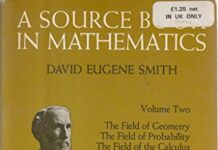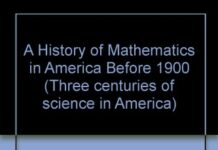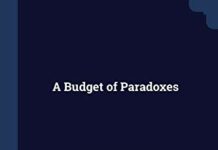
Ebook Info
- Published: 2020
- Number of pages: 738 pages
- Format: PDF
- File Size: 36.39 MB
- Authors: David Eugene Smith
Description
This book has been considered by academicians and scholars of great significance and value to literature. This forms a part of the knowledge base for future generations. So that the book is never forgotten we have represented this book in a print format as the same form as it was originally first published. Hence any marks or annotations seen are left intentionally to preserve its true nature.
User’s Reviews
Reviews from Amazon users which were colected at the time this book was published on the website:
⭐I bought the Kindle edition. But the math equations show up as unreadable random symbols/letters. I would not recommend the digital edition. I asked for a refund within minutes.
⭐The footnotes contained in the book are very helpful. I bought this book some few years ago and stiff look upon the pages for referencing and clarification.
⭐This cheapest and oldest of the various source books available is unfortunately also the poorest by a comfortable margin.Translation and commentary for the various selections were outsourced to numerous non-experts, giving the whole book an incohesive and amateurish feel. For example, we are told in a footnote on page 619 to “see the various encyclopedias” for more biographical information on a particular author. Surely readers who are not familiar with the concept of encyclopedias could benefit from this information much earlier.By the same token, the editorial material is not to be trusted. In the selections of Leibniz’s writings on the calculus the translator claims to have “corrected several mistakes.” She has, but she has also introduced as many new ones. Thus the differentiation rule for 1/x^a is given incorrectly on p. 622, and on p. 625 it says dx where it should be dy, even though both are correct in the original.Again, on p. 648 we find Johann Bernoulli taunting an unnamed target by writing that “their golden theorems, which they imagine known to no one, have been published by others long before.” According to the translator “this remark is to be regarded as a covert thrust at Newton,” which is certainly not the case. It is his brother Jacob that Johann is mocking in this passage. Jacob had indeed called his formula for the radius of curvature a “golden theorem” when he published it in 1694, for which he was promptly ridiculed by Huygens and Leibniz who already knew this result.
⭐For students of the history of maths, Smith provides you with a very convenient reference. He has gone back to many of the original papers by Newton, Pascal and others, and gathered 125 of these into this book. You can search for insight into how those luminaries made their important discoveries. As an added utility, the papers have been translated into English.An amazing time saver. For he lets you access the papers without any intermediary. The alternative would be to spend months searching in some large research library. And also probably having to order copies made from other libraries. At non-trivial cost in time and money.
⭐Mathematics was never easy and looking at these classicreproductions you really get a feel of the ignoranceof even the greatest men in mathematics.Here you can see them struggle to invent new ideasthat made possible our scientific and technical culture.I think this kind of book is invaluable to the studentwho wishes to actually understand.Some of the papers are almost impossibly difficult.It is a very good book!
Keywords
Free Download A source book in mathematics in PDF format
A source book in mathematics PDF Free Download
Download A source book in mathematics 2020 PDF Free
A source book in mathematics 2020 PDF Free Download
Download A source book in mathematics PDF
Free Download Ebook A source book in mathematics




